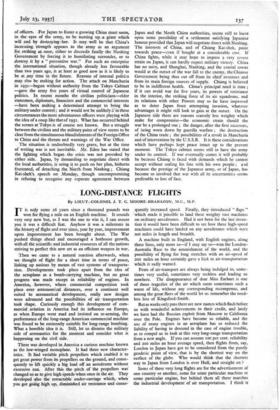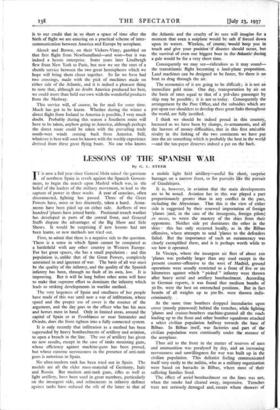LONG-DISTANCE FLIGHTS
By LIEUT.-COLONEL J. T. C. MOORE-BRABAZON, M.C., IT is only some 26 years since a thousand pounds was won for flying a mile on an English machine. It sounds very easy now but, as I was the one to win it, I can assure you it was a difficult feat. Anyhow it was a milestone in the history of flight and ever since, year by year, improvement upon improvement has been brought about. The War pushed things ahead and encouraged a hothouse growth, with all the scientific and industrial resources of all the nations striving to perfect this new art as an efficient weapon in war.
Then we came to a natural reaction afterwards, when we thought of flight for a short time in terms of peace, linking up nations by means of vast systems of transporta- tion. Developments took place apart from the idea of the aeroplane as a bomb-carrying machine, but no great progress was made except in reliability of engines. In America, however, where commercial competition took place over astronomical distances, over a continent well suited to aeronautical development, really new designs were advanced and the possibilities of air transportation took shape. Curiously enough this development of com- mercial aviation in America had its influence on Europe, as when Europe went mad and insisted on re-arming, the performance of the long-range American commercial machine was found to be eminently suitable for long-range bombing. What a horrible idea it is. Still, let us dismiss the military side of aeronautics for the moment and consider what is happening on the civil side.
There was developed in America a curious machine known as the low-winged monoplane. It had three new character- istics. It had variable pitch propellers which enabled it to get great power from its propellers on the ground, and conse- quently to lift quickly a big load off an aerodrome without excessive run. After this the pitch of the propellers was changed so as to give high speeds when once in the air. They developed also the retractable under-carriage which, when you got going high up, diminished air resistance and conse- quently increased speed. Finally, they introduced " flaps " • which made it possible to land these weighty vast machines on ordinary aerodromes. Had it not been for the last inven- tion it would have been difficult to see how these high-speed machines could have landed on any aerodromes which were not miles in length and breadth.
A machine built in England, with English engines, along these lines, only more so—if I may say so—won the London- Australia Race to the astonishment of the world, and the possibility of flying for long stretches with an air-speed of 200 miles an hour certainly gave a kick to air-transportation which it sadly wanted.
Feats of air-transport are always being indulged in, some- times very useful, sometimes very reckless and leading us nowhere. The disappearance of dear Miss Earhart is one of those tragedies of the air which seem sometimes such a waste of life, without any corresponding recompense, and among the great fliers of the world let us remember the need- less loss of Kingsford-Smith.
But as weeks only pass there are new names which flash before us with wonderful achievements to their credit, and lately we have had the Russian exploit from Moscow to California over the Pole. Engines have become so reliable, and the use of many engines in an aeroplane has so reduced the liability of having to descend in the case of engine trouble, as to compel us to look at this very long-range transportation from a new angle. If you can assume too per cent. reliability and 200 miles an hour average speed, then flights from, say, London to Japan have got to be considered from the purely geodesic point of view, that is by the shortest way on the surface .of the globe. Who would think that the shortest way to Japan from London is over Hull, and straight on ?
Some of these very long ffights are for the advertisement of one country or another, some for some particular machine or some particular engine, but behind them all there marches the industrial developinent of air transportation. I think it is to our credit that in so short .a -space of time after the birth of flight we are entering on a practical scheme of inter- communication between America and Europe by aeroplane.
Alcock and Brown, on their Vickers-Vimy, gambled on that first flight from Newfoundland—and won—but it was indeed a heroic enterprise. Some years later Lindbergh flew from New York to Paris, but now we see the start of a shuttle service between the two great hemispheres which we hope will bring them closer together. So far we have had two crossings, made with the pick of machines made on either side of the Atlantic, and it is indeed a pleasant thing to note that, although no doubt America produced her best, we could more than hold our own with the wonderful products from the Medway.
This service will, of course, be for mail for some time. Much has got to be learnt. Whether during the winter a direct flight from Ireland to America is possible, I very much doubt. Probably during this season a Southern route will have to be taken, anyhow going to America, although perhaps the direct route could be taken with the prevailing trade south-west , winds coming back from America. Still, Whatever is best will soon be known with the weekly experience derived from these great flying boats. No one who knows the Atlantic and the cruelty of its seas will imagine for a moment that even a seiPlane -would be safe if forced down upon its waters. Wireleii, of course; would keep you in touch and give your position*. if disaster should occur, but the survival of even our biggest boat in the -Atlantic during a gale would be for a very short time.
Consequently we may see—ridiculous as it may sound— the transatlantic flight becoming a land-plane proposition. Land machines can be designed to be-faster, for there is no boat to drag through the air.
The economics of it are going to be difficult; it is not an immediate gold mine. One day, transportation by air on the basis of rates equal to that of a 3rd-class passenger by ship may be possible; it is not so today. Consequently the arrangement by the Post Office, and the subsidies which are put upon our shoulders to develop these great links throughout the world, are fully justified.
I think we should be indeed proud in this country, harassed as we have been by slumps, re-armaments, and all the horrors of money difficulties, that in this first amicable rivalry in the linking of the two continents we have pmt into the air something which is probably the best in the world —and the tax-payer deserves indeed a pat on the back.































































 Previous page
Previous page